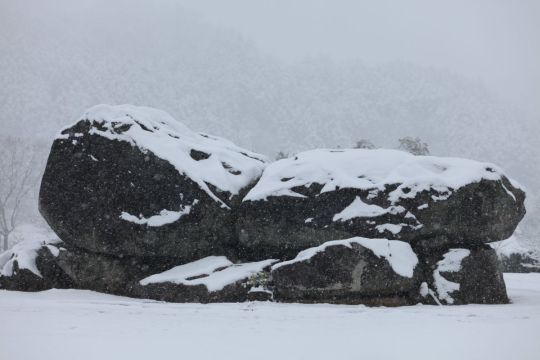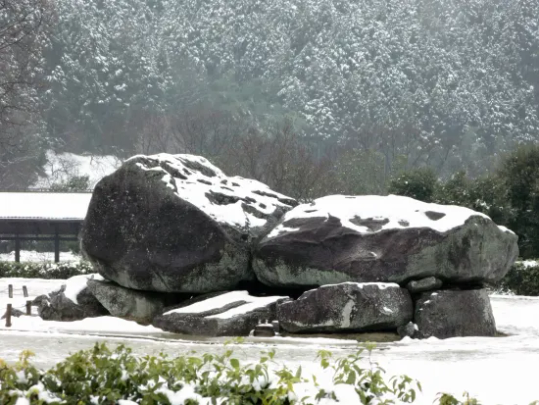#ピリオダスカ
Explore tagged Tumblr posts
Text



Sean bienvenidos a un nueva entrega un tanto especial, ya que tengo el gusto de presentaros Ishibutai, localizado en la prefectura de Nara data del periodo Asuka(592-710). - En un principio se barajaron hipótesis de que podría haber sido utilizado para espectáculos, en la década de los 30, Ishibutai es un kofun y os estaréis preguntando ¿no se supone que tenían ojo de cerradura? - Los podian a ver de muchos tipos se empiezan a construir en el año 300 al 592 d.c pero eso será otro capítulo de la arqueología y prehistoria japonesa. La tumba pudo pertenecer a Soga no Umako un político y ocupa una extensión de 54 m es la mayor estructura megalítica conocida en Japón. - ¿Hasta cuando estuvo utilizada? la edad de uso os dejará helados se construyó en el siglo VI y estuvo hasta el siglo VII para ser más exactos en este segundo dato en el 626 d.c. - En 1957 fue nombrado patrimonio nacional por la Unesco, ¿Cuánto pesa esta mole? un total de 30 rocas que le suman un peso aproximadamente de 2300 toneladas y las piedras del techo suman una friolera de 77 toneladas aproximadamente. - Espero que os haya gustado y nos vemos en una nueva publicación de arqueología y prehistoria arqueología japonesa. - Welcome to a new, somewhat special installment, as I have the pleasure of introducing you to Ishibutai, located in the Nara prefecture, dating from the Asuka period (592-710). - At first, hypotheses were considered that it could have been used for shows, in the 1930s, Ishibutai is a kofun and you may be wondering, aren't they supposed to have a keyhole? - You could see them of many types, they began to be built in the year 300 to 592 AD but that will be another chapter of Japanese archeology and prehistory. The tomb could have belonged to Soga no Umako, a politician, and occupies an area of 54 m, it is the largest megalithic structure known in Japan. - Until when was it used? The age of use will leave you frozen. It was built in the 6th century and was there until the 7th century to be more exact in this second data in 626 AD. - In 1957 it was named a national heritage site by UNESCO. How much does this mass weigh? a total of 30 rocks that add up to a weight of approximately 2,300 tons and the stones of the roof add up to a whopping 77 tons approximately. - I hope you liked it and see you in a new publication of archeology and prehistory Japanese archaeology. - 新しい、ちょっと特別な回へようこそ。今回は、飛鳥時代 (592 ~ 710 年) に遡る、奈良県にある石舞台についてご紹介したいと思います。 - 当初は、1930 年代にショーに使用されたのではないかという仮説が考えられていました。 石舞台は古墳ですが、鍵穴があるはずではないかと疑問に思うかもしれません。 - さまざまなタイプのそれらを見ることができ、それらは西暦 300 年から 592 年に建てられ始めましたが、それは日本の考古学と先史学の別の章となるでしょう。 この墓は政治家蘇我馬子の墓と考えられ、面積は54メートルあり、知られている巨石建造物としては日本最大である。 - いつ頃まで使われていましたか? この 2 番目のデータは西暦 626 年で、6 世紀に建てられ、より正確には 7 世紀まで存在していました。 - 1957 年にユネスコによって国家遺産に指定されましたが、この塊の重さはどれくらいでしょうか? 30 個の石を合計すると約 2,300 トン、屋根の石を合計すると約 77 トンにもなります。 - 気に入っていただければ幸いです。考古学と先史時代の日本の考古学の新しい出版物でお会いしましょう。
#先史時代#原史時代#メガリス#歴史#日本の歴史#考古学遺跡#考古学者#考古学#日本#人類の歴史#県#県ジャポン#ピリオダスカ#ピリオドコフン#墓#クラノガ#ソガノウマコ#prehistoria#protohistoria#megalito#historia#historiajapón#restosarqueológicos#arqueólogo#arqueologas#japan#japón#historiadelahumanidad#prefecturas#prefecturasjapon
57 notes
·
View notes